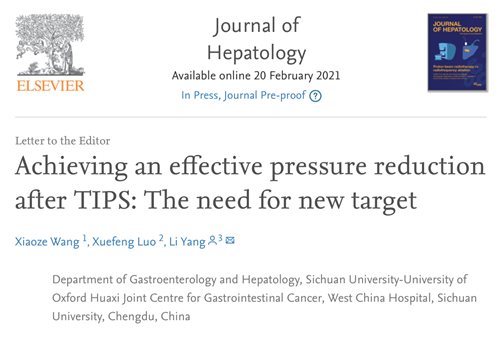From January to February, 2021, the team lead by Prof. Yang Li and Associate Professor Luo Xuefeng from the Department of Gastroenterology and Sichuan University-Oxford University Huaxi Gastrointestinal Cancer Center published two cirrhosis-related papers named “Endoscopic Cyanoacrylate Injection vs BRTO for Prevention of Gastric Variceal Bleeding: A Randomized Controlled Trial” on Hepatology (IF: 14.679) and “Achieving an effective pressure reduction after TIPS: The need for new target” on Journal of Hepatology (IF: 20.582) respectively.
Associate Professor Luo Xuefeng and Dr. Wang Xiaoze are the first authors of the two papers respectively, and Prof. Yang Li is the corresponding author. West China Hospital, Sichuan University and Sichuan University-Oxford University Huaxi Gastrointestinal Cancer Center are the first institute and corresponding institute of the two papers.

About 20% of patients with cirrhosis suffered from Gastric varices (GVs). Compared with esophageal varices (EVs), the incidence of GVs is lower. Mortality due to rupture of gastric varices are higher. There are many shortcomings in existing clinical researches, and the best treatment strategy for GVs has not been fully determined. Prof. Yang Li’s team conducted a prospective randomized controlled clinical study to explore the efficacy and safety of endoscopic cyanoacrylate injection and BRTO in preventing GVs rebleeding. Their studies found that BRTO was more effective than endoscopic cyanoacrylate injection in preventing gastric variceal rebleeding. There was no significant difference in complications (such as esophageal variceal aggravation rate and ascites aggravation rate) and mortality between the two groups, and the total hospitalization cost can be reduced. BRTO can thus be used as the first choice for gastric variceal bleeding.

Transjugular intrahepatic portosystemic shunt (TIPS) is widely used to treat portal hypertension and its complications. Which diameter of a stent should be selected for TIPS to balance the decompression of portal venous system and avoid excessive shunt? This has become a hot issue at present. Prof. Jaume Bosch is a global leader in portal hypertension. In September 2020, he published an article entitled Small Diameter Shunts Should Lead to Safe Expansion of the Use of TIPS in the Expert Opinion section of Journal of Hepatology, pointing out that small-diameter TIPS is expected to obtain sufficient shunt effect and reduce the risk of hepatic encephalopathy and liver function damage. In view of this, the digestive intervention team of WCH retrospectively analyzed the clinical data of patients with PSG greater than 12mmHg and less than 12mmHg after TIPS from June 2015 to April 2019, finding that there was no difference in both rebleeding rate and mortality rate. This study was published in Journal of Hepatology, further confirming Prof. Jaume Bosch’s hypothesis of small-diameter TIPS with reliable clinical data.
Under the leadership of Prof. Yang Li and Associate Professor Luo Xuefeng, the digestive intervention team focused on multidisciplinary diagnosis and treatment of chronic liver diseases, cirrhosis, liver tumors and liver vascular diseases, and has gained rich fruits in basic and clinical research fields. The team was invited to revise the seventh edition of Baveno Consensus, the most influential guideline for diagnosis and treatment of portal hypertension in the world; moreover, as a main member, it had compiled five guidelines for the Chinese Medical Association and Chinese Medical Doctors' Association.